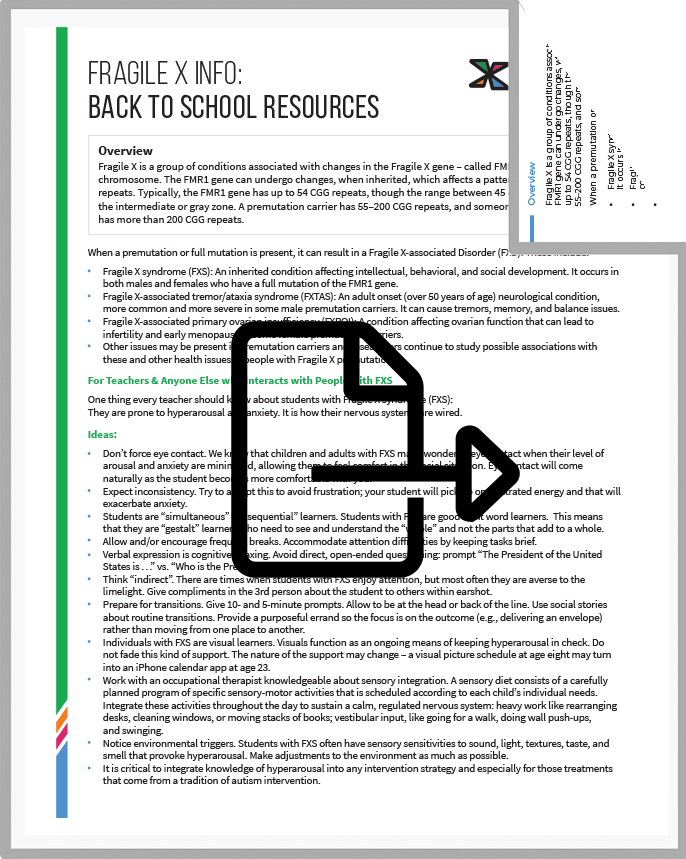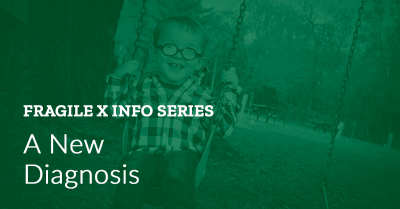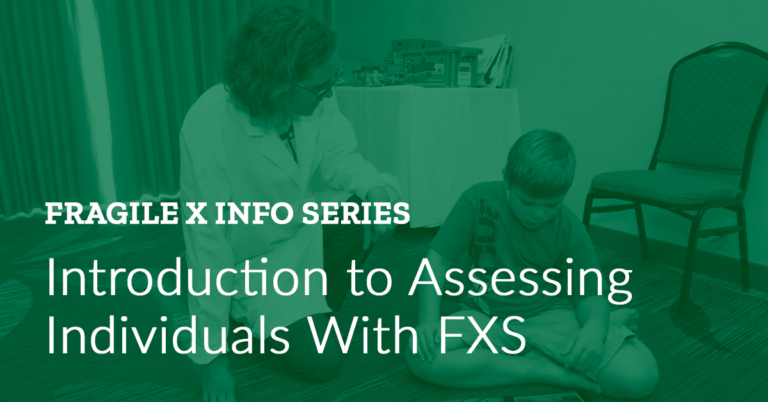Fragile X Info Series
overview of fragile x syndrome and associated disorders
Fragile X is a group of conditions associated with changes in the Fragile X gene — called FMRl — located on the X chromosome. The FMRl gene can undergo changes, when inherited, which affects a pattern of DNA called CGG repeats. Typically, the FMRl gene has up to 54 CGG repeats. The range of 45–54 repeats is called the intermediate or “gray zone.” A premutation carrier has 55–200 CGG repeats, and someone with a full mutation has more than 200 CGG repeats.
When a premutation or full mutation is present, it can result in a Fragile X-associated disorder (FXD). These include:
FXS
FRAGILE X SYNDROME
FXS is an inherited disorder affecting intellectual, behavioral, and social development. It occurs in both males and females who have a full mutation of the FMR1 gene.
FXTAS
FRAGILE X-ASSOCIATED TREMOR/ATAXIA SYNDROME
FXTAS is an adult onset (over 50 years of age) neurological condition, more common and more severe in some male premutation carriers. It can cause tremors, memory, and balance issues.
FXPOI
FRAGILE X-ASSOCIATED PRIMARY OVARIAN INSUFFICIENCY
FXPOI is a condition affecting ovarian function that can lead to infertility and early menopause in some female carriers.
OTHER PREMUTATION CONDITIONS
Other issues may be present in premutation carriers and researchers continue to study possible associations with these and other health issues in people with Fragile X premutations.
KNOW THEIR STRENGTHS
Common strengths associated with Fragile X syndrome include:
- Good visual memory.
- Sense of humor.
- Desire to be helpful.
- Empathic nature.
- Gift for mimicry.
To work with their strengths:
- Provide opportunities to be of assistance.
- Encourage providing emotional support to peers.
- Use modeling as a primary teaching technique.
- Embed academics into useful and practical tasks, such as taking attendance (counting) or ordering from a menu (reading).

For Teachers and Others Who Interacts with People with Fragile X Syndrome
One thing every teacher should know about students with Fragile X syndrome: They’re prone to hyperarousal and anxiety. It’s how their nervous systems are wired.
- Don’t force eye contact. We know that children and adults with Fragile X syndrome make wonderful eye contact when their level of arousal and anxiety are minimized, allowing them to feel comfort in the social situation. Eye contact will come naturally as the student becomes more comfortable with you.
- Expect inconsistency. Try to accept this to avoid frustration; your student will pick up on frustrated energy and that will exacerbate anxiety.
- Students are “simultaneous” vs “sequential” learners. Students with Fragile X syndrome are good sight word learners. This means that they are “gestalt” learners who need to see and understand the “whole” and not the parts that add to a whole.
- Allow and encourage frequent breaks. Accommodate attention difficulties by keeping tasks brief.
- Verbal expression is cognitively taxing. Avoid direct, open-ended questioning: prompt “The President of the United States is …” vs. “Who is the President of the United States?”
- Think “indirect.” There are times when students with Fragile X syndrome enjoy attention, but most often they are averse to the limelight. Give compliments in the third person about the student to others within earshot.
- Prepare for transitions. Give 10- and 5-minute prompts. Allow to be at the head or back of the line. Use social stories about routine transitions. Provide a purposeful errand so the focus is on the outcome (e.g., delivering an envelope) rather than moving from one place to another.
- They are visual learners. Visuals function as an ongoing means of keeping hyperarousal in check. Do not fade this kind of support. The nature of the support may change – a visual picture schedule at age eight may turn into an iPhone calendar app at age 23.
- Work with an occupational therapist knowledgeable about sensory integration. A sensory diet consists of a carefully planned program of specific sensory-motor activities that is scheduled according to each child’s individual needs. Integrate these activities throughout the day to sustain a calm, regulated nervous system: heavy work like rearranging desks, cleaning windows, or moving stacks of books; vestibular input, like going for a walk, doing wall push-ups, and swinging.
- Notice environmental triggers. Students with Fragile X syndrome often have sensory sensitivities to sound, light, textures, taste, and smell that provoke hyperarousal. Make adjustments to the environment as much as possible.
- Integrate knowledge of hyperarousal into any intervention strategy. This is critical, especially for those treatments that come from a tradition of autism intervention.
Ideas for the Transition Back to School
Going back to school after a relaxing summer can be quite a challenge. If the student is going back to the same school with the same teaching staff, the transition process is easier and requires less support. When the student changes schools, neighborhoods, or programs, additional support is required. Be sure to allow plenty of time to make all the transitions. Several strategies can help in guiding a successful transitions:
- Tell a story with pictures. Prior to the start of school, take pictures of the school, classroom, playground, and school staff. These pictures can then be incorporated into a social story about going back to school. Social stories can help reduce anxiety.
- Know how they’ll get to school. Whether they’re walking, carpooling, taking the bus, or riding their bike, choose a route for them to stick with and teach them what time they need to leave to be on time.
- Start planning the night before. Lay out clothes, and plan breakfast and lunch.
- Plan a transition object for your child to take into the classroom. This can be something simple like an apple or some flowers.
- Find a friend. Whenever possible, it’s helpful to find classmates or a sibling to accompany them before, during, or after school.
- Establish routines. Routine brings predictability, which is self-calming and reassuring. Use visuals if needed. When they get comfortable with an early morning routine, for example, entering the classroom and starting the day simply becomes an extension of that process.
- Use a back-and-forth notebook. This is between you and the teacher so you know what’s happening at school, and prompts discussions with your child.
- Plan a treat every Friday. Choose an activity or other treat to celebrate the week.
See also: Back-to-school articles.
TREATMENT RECOMMENDATIONS
Our recommendations on education from the Fragile X Clinical & Research Consortium.
Educational Guidelines for Fragile X Syndrome: General
Topics include: Response to intervention, multi-tiered system of supports, inclusion, the IEP (individualized education plan), educational strategies, early intervention through to post-secondary school, description of the various assessments, and available school services.
Educational Guidelines for Fragile X Syndrome: Early Childhood (Birth to 5 Years)
Topics include: Early intervention, early childhood special education, assessment through child find activities, early childhood prevention and services, and IEP checklists.
Educational Guidelines for Fragile X Syndrome: Elementary Students
Topics include: Adaptive PE, counseling services, evacuation planning, extended school year, health care plan, occupational therapy, physical therapy, social skills training, speech-language therapy, transportation, applied behavior analysis therapy; and developmental, functional behavior, and psychoeducational assessments.
Educational Guidelines for Fragile X Syndrome: Middle and High School Students
Assessments, services, and strategies for middle school, high school, and post-secondary school.
How We Can Help
The NFXF is dedicated to serving the entire Fragile X community to live their best lives by providing the knowledge, resources, and tools, until, and even after more effective treatments and a cure are achieved. Learn more with Fragile X 101.
If you have questions please reach out to us at treatment@fragilex.org or call (800) 688-8765.
THANK YOU
Featured image by PublicDomainPictures↗ from Pixabay↗


















